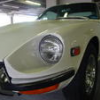First of all, the chart (its from one of the Nissan Motor Co. Ltd. Japan 10 year report books) doesn't give a breakdown including PS30 and PS30-SB Fairlady Z432 and Fairlady Z432-R models, so they are not in that particular mix. The bars on the chart show total S30-prefixed production and the total (Japanese market only) HS30-prefixed production in proportion to eachother. Kats has marked in green the proportions of the HS30-prefixed cars at the top of the '71, '72 & '73 year bars. The numbers on the vertical axis are thousands of units.
Secondly, the Japanese market L24-engined models (HS30-S 'Fairlady 240Z', HS30-D 'Fairlady 240Z-L' and HS30-H 'Fairlady 240ZG') were only sold from late 1971 through late 1973, and in parallel with the (four) Japanese market 2-litre models, so their uptake - being more expensive to buy and to own than two of the 2-litre models - was reduced. In fact, a fully optioned HS30-prefixed variant was a premium product in the Nissan showroom lineup. That explains somewhat why the proportions of L24-engined variants are smaller than the L20(A)-engined variants.
As Kats pointed out, cashed-up buyers tended to choose the Fairlady 240ZG over the 'Standard' spec Fairlady 240Z and the 'Deluxe' spec Fairlady 240Z-L, probably because of its radical looks and the reflected glow of the factory race cars. By late 1971 the 432 and 432-R were already the best part of two years old, so not 'The New Thing'. The 240ZG itself was a 'Deluxe' model with all the bells and whistles of the 240Z-L, but the addition of that factory body kit, so buyers tended the leap-frog the 240Z-L. All these factors combined to make the 240Z-L a relatively rare choice then, and therefore a relatively rare car today.
Yes, there are no hard numbers for the breakdown of HS30-S, HS30-D and HS30-H production. The chart that Kats posted is a rare clue to totals, but it doesn't give hard numbers. The Japanese Motor Industry Association kept records of year-on-year batches of chassis numbers, broken down by chassis prefix. Therefore we know the chassis number ranges for each year of production for the Japanese market HS30-prefixed variants, but not the sub-variant (S,D,H suffix) breakdowns.
Such is the mystique - and joy - of the Japanese market variants.
 Subscriber
Subscriber 2Points1,935Posts
2Points1,935Posts









